80x5 -
240x3 -
240x4 -
320x1 -
320x2 -
320x3 -
640x1 -
640x2
Set display option above.
Click on
images to enlarge. |
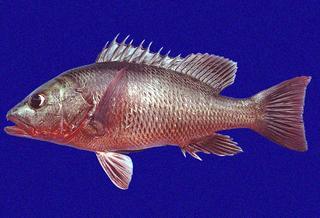
© Copyright Ross Robertson, 2006
· 12
Lutjanus colorado |
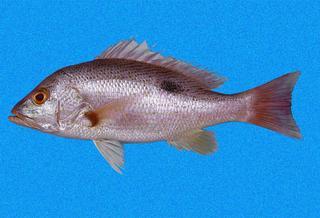
© Copyright Ross Robertson, 2006
· 12
Lutjanus guttatus |
|
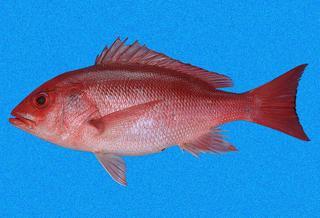
© Copyright Ross Robertson, 2006
· 12
Lutjanus peru |
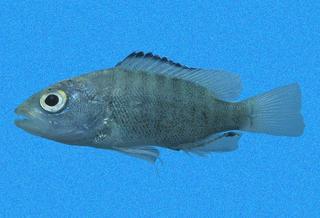
© Copyright Ross Robertson, 2006
· 12
Lutjanus novemfasciatus |
|

© Copyright Ross Robertson, 2006
· 12
Hoplopagrus |

© Copyright Ross Robertson, 2006
· 12
Hoplopagrus guentherii |
|
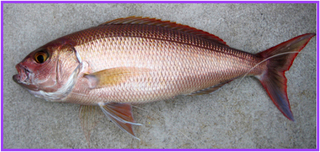
© Allen Hia Andrews, 2013
· 1
Pristipomoides filamentosus, Hawaiian pink snapper |
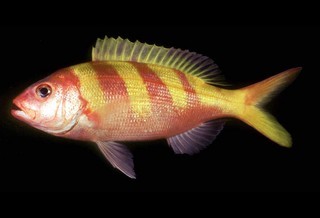
© Copyright John Rangall, 2006
· 0
Pristipomoides zonatus |
|
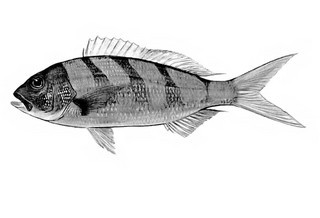
www.fao.org Copyright Michel Lamboeuf · 0
Pristipomoides zonatus |

© Copyright John Rangall, 2006
· 0
Pristipomoides |
|
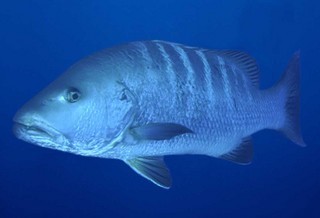
© Copyright Gerald Allen, 2006
· 0
Lutjanus |
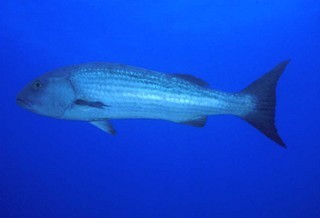
© Copyright Gerald Allen, 2006
· 0
Lutjanus aratus |
|
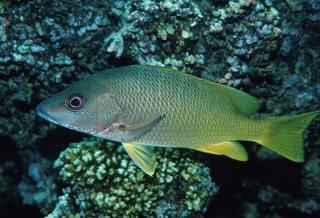
© Copyright Roger Steene, 2006
· 0
Lutjanus argentiventris |
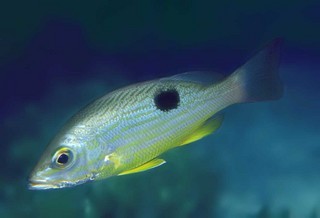
© Copyright Gerald Allen, 2006
· 0
Lutjanus guttatus |
|
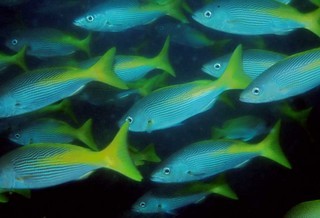
© Copyright Gerald Allen, 2006
· 0
Lutjanus inermis |
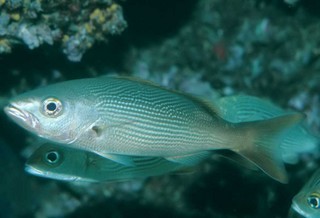
© Copyright Gerald Allen, 2006
· 0
Lutjanus inermis |
|
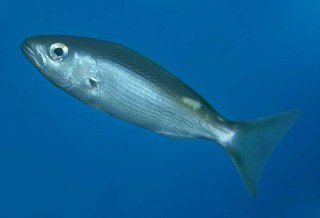
© Copyright Gerald Allen, 2006
· 0
Lutjanus inermis |
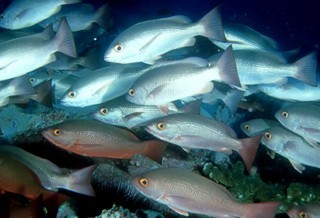
© Copyright Clay Bryce, 2006
· 0
Lutjanus jordani |
|
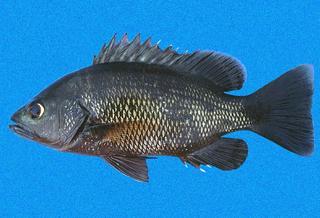
© Copyright Gerald Allen, 2006
· 0
Lutjanus jordani |

© Copyright Gerald Allen, 2006
· 0
Lutjanidae |
See
| | |
| | IDnature guides | |
| Overview |
Main identification features
- no scales - snout, under eye, lower jaw
- elongate, compressed
- 1d
- teeth on mouth roof
- preopercle serrated
FAMILY LUTJANIDAE
SNAPPERS, JOBFISHES, RABIRRUBIAS
Snappers are small to medium-sized fishes with an ovate to elongate, moderately compressed body. Other features include a single dorsal fin that may be notched between the spiny and soft parts, or sometimes has deeply notches between the spines; dorsal spines usually X, the soft rays 8-18; anal fin with III spines and 7-11 soft rays; tail fin with a straight to deeply forked edge; pelvic axillary scale process usually well-developed; jaws usually with more or less distinct canines; front and sides of roof of mouth usually with small conical teeth; scales rough; cheek and operculum scaly; snout, below eye and lower jaw scaleless.
Most snappers dwell in shallow to intermediate depths (to 100m) in the vicinity of reefs, although there are some species largely confined to depths between 100 and 500m. Snappers are active predators feeding mainly at night on a variety of items, but fishes are dominant in the diet of most species. Other common foods include crabs, shrimps, various other crustaceans, gastropods, cephalopods, and planktonic organisms, particularly urochordates. The maximum lifespan of snappers has been estimated between four and 21 years based on studies of growth rings on bony structures such as otoliths and vertebrae. In general the larger snappers have longer lifespans, perhaps in the range of 15-20 years. Snappers are good eating and are frequently offered at markets and restaurants.
The approximately 107 members of the 17 genera in the family are distributed in all tropical seas, but the majority inhabits the Indo-Pacific. The genus Lutjanus is the largest containing 64 species, including nine eastern Pacific representatives. In our region there are 12 species in four genera, including two Indo-Pacific species and 10 endemics.
|
| References |
- Abitia-Cárdenas, L.A., Rodríguez-Romero, J., Galván-Magaña, F., 1990., Observaciones tróficas de tres especies de peces de importancia comercial de Bahía Concepción, Baja California Sur, México., Inv. Mar. CICIMAR, 5:55-61.
- Aburto-Oropeza , O. and Balart, E. F., 2001., Community structure of reef fish in several habitats of a rocky reef in the Gulf of California., Marine Ecology, 22:283-305.
- Acero, A. and Franke, R., 2001., Peces del parque nacional natural Gorgona. En: Barrios, L. M. y M. Lopéz-Victoria (Eds.). Gorgona marina: Contribución al conocimiento de una isla única., INVEMAR, Serie Publicaciones Especiales No. 7:123-131.
- Acosta Salmón , H. and Martínez Fernández, E., 2000., Propuesta preliminar ... de concha nacar (Pteria sterna Gould, 1851) en la Bahía de la Paz, Baja California Sur, México. En Aburto Oropeza, O. y C. A. Sánchez Ortiz (Eds.). Recursos arrecifales del Golfo de California, …., Universidad Autónoma de Baja California Sur:95-106.
- Allen , G.R. and Robertson, D.R., 1997., An Annotated Checklist of the fishes of Clipperton Atoll, Tropical Eastern Pacific., Revista de Biologia Tropical, 45:813-843.
- Allen, G.R., 1985., Snappers of the world. An annotated and illustrated catalogue of lutjanid species known to date. FAO species catalogue. Vol. 6., FAO Fish. Synop. No 125, 125:208pp.
- Balart , E. F. , Castro-Aguirre , J. L. and De Lachica-Bonilla, F., 1997., Análisis comparativo de las comunidades ícticas de fondos blandos y someros de la Bahía de La Paz, B.C. S.. En Urbán Ramírez, J. y M. Ramírez Rodríguez (Eds.). La Bahía de La Paz investigación y conservación., Universidad Autónoma de Baja California Sur:177-188.
- Breder, C.M. Jr., 1936., Scientific results of the second oceanographic expedition of the "Pawnee" 1926. Heterosomata to Pediculati from Panama to Lower California., Bull. Bingham Oceanogr. Collect. Yale Univ., 2(3):1-56.
- Béarez, P., 1996., Lista de los Peces Marinos del Ecuador Continental., Revista de Biologia Tropical, 44:731-741.
- Castri-Aguirre, J.L., Espinoza-Pérez, H. and Schmitter-Soto, J.J., 2002., Lista sitemática, biogeográfica y ecológica de la ictiofauna estuarino lagunar y vicaria de México. En: Lozano-Vilano, M. L. (Ed.). Libro Jubilar en Honor al Dr. Salvador Contreras Balderas., Universidad Autonoma de Nuevo León:117-142.
- Castro-Aguirre , J. L. and Balart, E. F., 1997., Contribución al conocimiento de la ictiofauna de fondos blandos y someros de la Ensenada de La Paz y Bahía de La Paz, B.C.S.. En Urbán Ramírez, J. y M. Ramírez Rodríguez (Eds.). La Bahía de La Paz investigación y conservación., Universidad Autónoma de Baja California Sur:139-150.
- Castro-Aguirre, J.L. and Balart, E.F., 2002., La ictiofauna de las islas Revillagigedos y sus relaciones zoogeograficas, con comentarios acerca de su origen y evolucion. En: Lozano-Vilano, M. L. (Ed.). Libro Jubilar en Honor al Dr. Salvador Contreras Balderas., Universidad Autonoma de Nuevo León:153-170.
- Castro-Aguirre, J.L., 1999., Ictiofauna estuarino-lagunar y vicaria de México., Editorial Limusa S.A. de C.V.: 1-629pp.
- Cuesta, T.C., 1932., Lista de los peces de las costas de la Baja California., Inst. Biol. Mexico, Anal, 3(1):75-80.
- Cuvier , G. and Valenciennes, A., 1830., Historie naturelle des poissons. Tome Sixième. Livre sixième. Partie I. Des Sparoïdes; Partie II. Des Ménides., Histoire Naturelle Des Poissons, 6:1-559.
- De la Cruz , J. , Galvan , F. , Abitia , L. A. , Rodriguez , J. and Gutierrez, F. J., 1994., Lista sistematica de los peces marinos de Bahia Magdalena, Baja California Sur (Mexico). Systematic List of marine fishes from Bahia Magdalena, Baja California Sur (Mexico)., Ciencias Marinas, 20:17-31.
- Delfin, F. T., 1902., Nuevas Especies de la Familia Rajidae., Revista Chilena de Historia Natural, 6:262-270.
- Dorda, J. and Perdices, A., 1997., Ictiofauna continental de la Isla de Coiba (Panamá). En Castroviejo, S. y Velayos M. (Eds): Flora y fauna del Parque Nacional de Coiba (Panamá). Agencia Española de Cooperación Internacional., Serviprint:155-175.
- Edgar, G.J. Banks, S., Fariña, J.M., Calvopiña, M. and Martínez, C., 2004., Regional biogeography of shallow reef fish and macro-invertebrate communities in the Galapagos archipelago., Journal of Biogeography, 31:1107-1124.
- Elorduy Garay , J. F. and Jiménez Gutiérrez, S. V., 2000., Metodologías para el estudio de los peces de arrecife. En Aburto Oropeza, O. y C. A. Sánchez Ortiz (Eds.). Recursos arrecifales del Golfo de California, estrategias de manejo para las especies marinas de ornato., Universidad Autónoma de Baja California Sur:72-82.
- Eschmeyer , W. N. , Herald , E. S. and Hamman, H., 1983., A field guide to Pacific coast fishes of North America from the Gulf of Alaska to Baja California. Peterson Field Guide Ser. 28., Houghton Mifflin:336pp.
- Findley, L.T., Hendrickx, M.E., Brusca, R.C., van der Heiden, A.M., Hastings, P.A., Torre, J., 2003., Diversidad de la Macrofauna Marina del Golfo de California, Mexico., CD-ROM versión 1.0. Projecto de la Macrofauna del Golfo . Derechos reservados de los autores y Conservación Internacional.
- Fischer , W. , Krup , F. , Schneider , W. , Sommer , C. , Carpenter , K. E. and Niem, V. H., 1995., Guia FAO para la Identificacion de Especies de para los fines de la Pesca. Pacifico Centro-Oriental. Volumen III. Vertebrados - Parte 2., FAO3:1201-1813.
- Fowler, H.W., 1944., Results of the Fifth George Vanderbilt Expedition (1941) (Bahamas, Caribbean sea, Panama, Galapagos Archipelago and Mexican Pacific Islands). The Fishes., Acad. Nat. Sci. Philadel., Monographs, 6:57-529.
- Franke , R. and Acero P., A., 1992., Peces Lutjanidos del Parque Gorgona Pacifico Colombiano (Osteichthyes: Lutjanidae)., Revista de Biología Marina, Valparaiso, 27:59-71.
- Galván-Magaña, F., Abitia-Cárdenas, L.A., Rodríguez-Romero, J., Pérez-España, H., Chávez-Ramos, H., 1996., Systematics list of the fishes from Cerralvo island, Baja California Sur, Mexico., Ciencias Marinas, 22:295-311.
- Galván-Magaña, F., Gutiérrez-Sánchez, F., Abitia-Cárdenas, L.A., Rodríguez-Romero, J., 2000., The distribution and affinities of the shore fishes of the Baja California Sur lagoons. In Aquatic Ecosystems of Mexico: Status and Scope. Eds. M. Manuwar, S.G. Lawrence, I.F. Manuwar & D.F. Malley. Ecovision World Monograph Series., Backhuys Publishers:383-398.
- Gill, T.N., 1862., Catalogue of the fishes of Lower California, in the Smithsonian Institution, collected by Mr. J. Xantus. Part 3., Proc. Acad. Nat. Sci. Phila., 14:249-262.
- Günther, A., 1864., Report of a collection of fishes made by Messrs. Dow, Godman and Salvin in Guatemala. Part first., Proc. Zool. Soc. London, 1864(1):144-154.
- Hildebrand, S.F., 1925., Fishes of the Republic of El Salvador, Central America., Bulletin of the Bureau of Fisheries., 41:236-287.
- Hildebrand, S.F., 1946., A descriptive catalog of the shore fishes of Peru., Bull. U.S. Nat. Mus., 189:1-530.
- Humann, P., 1993., Reef Fish Identification: Galapagos., New World Publishing:192pp.
- Jimenez-Prado, P., Béarez, P., 2004., Peces marinos del Ecuador continental / Marine fishes of continental Ecuador., SIMBIOE/NAZCA/IFEA tomo 1 y 2.
- Jordan , D.S. and Bollman, C.H., 1890., Descriptions of new species of fishes collected at the Galapagos Islands and along the coast of the United States of Colombia, 1887-88, by the U.S. Fish Commission steamer 'Albatross'., Proc. U.S. Nat. Mus., 12:149-183.
- Jordan , D.S. and Evermann, B.W., 1898., The fishes of North and Middle America: a descriptive catalogue of the species of fish-like vertebrates found in the waters of North America, north of the Isthmus of Panama. Part II., Bull. U.S. Nat. Mus., 47:1241-2183.
- Jordan , D.S. and Gilbert, C.H., 1882., Description of thirty-three new species of fishes from Mazatlan, Mexico., Proc. U.S. Nat. Mus., 4(1881):338-365.
- Jordan , D.S. and Gilbert, C.H., 1882., Descriptions of nineteen new species of fishes from the Bay of Panama., Bull. U.S. Fish Comm., 1:306-335.
- Jordan , D.S. and Gilbert, C.H., 1882., List of Fishes now in the Museum of Yale College, Collected by Prof. Frank H. Bradley, at Panama, with Descriptions of Three New Species., Proc. U.S. Nat. Mus., 5:620-632.
- Jordan , D.S. and Gilbert, C.H., 1883., Catalogue of the fishes collected by Mr. John Xantus at Cape San Lucas, which are now in the United States National Museum, with descriptions of eight new species., Proc. U.S. Nat. Mus., 5(1882):353-371.
- Jordan , D.S. and Gilbert, C.H., 1883., List of the fishes now in the museum of Yale College, collected by Prof. Frank H. Bradley at panama, with descriptions of three new species., Proc. U.S. Nat. Mus., 5(1882):620-632.
- Jordan , and McGregor,., 1898., List of fishes collected at the Revillagigedo archipelago and neighboring islands., Rept. U.S. Fisheries Comm., 24:271-284.
- Jordan, D.S., 1895., The fishes of Sinaloa., Proceedings of the California Academy of Sciences (Series 2), 5:377-514.
- Kendall , W.C. and Radcliffe, L., 1912., The shore fishes. Reports on the scientific results of the expedition to the eastern tropical Pacific, ... by the U.S. Fish Commission steamer ALBATROSS, from October, 1904, to March, 1905, Lieut. Commander L.M. Garret, U.S.N., Commanding. XXV., Mem. Mus. Comp. Zool., 35(3):75-171.
- Lacepède, B. G. E., 1801., Histoire naturelle des poissons., Histoire Naturelle Des Poissons, 3:1-558.
- Lopez , M. I. and Bussing, W. A., 1982., Lista provisional de los peces marinos de la Costa Rica., Revista de Biologia Tropical, 30(1):5-26.
- Love, M.S., Mecklenburg, C.W., Mecklenburg, T.A., Thorsteinson, L.K., 2005., es of the West Coast and Alaska: a checklist of North Pacific and Artic Ocena species from Baja California to the Alaska-Yukon border., U.S. Department of the Interior, U.S. Geological Survey, Biological Resources Division, 288pp.
- Madrid Vera , J. , Ruíz Luna , A. and Rosado Bravo, I., 1998., Peces de la plataforma continental de Michoacán y sus relaciones regionales en el Pacífico mexicano., Revista de Biologia Tropical, 42(2):267-276.
- McCosker , J.E. and Rosenblatt, R.H., 1975., Fishes collected at Malpelo Island. In Graham, J.B. (ed.) The Biological Investigation of Malpelo Island, Colombia., Smithsonian Contrib. Zool., 176:91-93.
- Meek , S.E. and Hildebrand, S.F., 1925., The marine fishes of Panama. Part II., Field Mus. Nat. Hist., Zool. Ser. Publ., XV:331-707.
- Molina, L., Danulat, E., Oviedo, M., González, J.A., 2004., Guía de especies de interés pesquero en la Reserva Marina de Galápagos., Fundación Charles Darwin / Agencia Espeñola de Cooperación Internacional / Dirección Parque Nacional Galápagos, 115pp.
- Morales-Nin, B., 1994., Growth of demersal fish species in the Mexican Pacific Ocean., Marine Biology, 121:211-217.
- Nelson, J.S., 1984., Fishes of the World (Third edition)., John Wiley and Sons:523pp.
- Nichols , J.T. and Murphy, R. C., 1922., On a collection of marine fishes from Peru., Bull. Amer. Mus. Nat. Hist., 46:501-516.
- Orellana, J.J., 1985., Marine Fishes of Los Cóbanos: Fishes of El Salvador., Sigma Found:126pp.
- Osburn , R. C. and Nichols, J. T., 1916., Shore Fishes Collected by the 'Albatross' Expedition in Lower California with Descriptions of New Species., Bull. Amer. Mus. Nat. Hist., 35:139-181.
- Peters,., 1869., Über neue oder weniger bekannte Fische des Berliner Zoologischen Museums., Monatsb. Akad. Wiss. Berlin, 1869:703-711.
- Phillips, P. C., 1981., Annotated Checklist of Fishes at Jiquilisco Bay, El Salvador., Revista de Biologia Tropical, 29:45-58.
- Pérez-Mellado, J., Findley, LL. F., 1985., Evaluación de la ictiofauna acompañante del camarón capturado en las costas de Sonora y norte de Sinaloa, México. In Yáñez-Arancibia, A. (Ed.) Recursos pesqueros potenciales de México: La pesca acompañante del camarón., Universidad Nacional Autónoma de México: Cap. 5:201-254.
- Ramírez Rodríguez, M., 1997., Producción pesquera en la Bahía de La Paz, B.C.S.. En Urbán Ramírez, J. y M. Ramírez Rodríguez (Eds.). La Bahía de La Paz investigación y conservación., Universidad Autónoma de Baja California Sur:273-282.
- Ricker, K.E., 1959., Fishes collected from the Revillagigedo Islands during the 1954-1958 cruises of the "Marijean."., Univ. Brit. Columbia Inst. Fish., Mus. Contrib., 4:10pp.
- Ricker, K.E., 1959., Mexican shore and pelagic fishes collected from Acapulco to Cape San Lucas during the 1957 cruise of the "Marijean"., Univ. Brit. Columbia Inst. Fish., Mus. Contrib., 3:18pp.
- Robertson , D.R. and Allen, G.A., 1996., Zoogeography of the shorefish fauna of Clipperton Atoll., Coral Reefs, 15:121-131.
- Rodríguez-Romero, J., Abitia-Cárdenas, L.A., Galván-Magaña, F., Gutiérrez-Sanchez, F.J., Aguilar-Palomino, B., Arvizú-Martínez, J., 1998., Ecology of fish communities from the soft bottoms of Bahía Concepción, México., Arch. Fish. Mar. Res., 46:61-76.
- Rojas , J. R. , Pizarro , J. F. and Castro, M.V., 1994., Diversidad y Abundancia íctica en tres áreas de manglar en el Golfo de Nicoya, Costa Rica., Revista de Biologia Tropical, 42:663-672.
- Rojas M., J. R., 1996., Hábitos alimentarios del Pargo Mancha Lutjanus guttatus (Pisces: Lutjanidae) en el Golfo de Nicoya, Costa Rica., Revista de Biologia Tropical, 44/45:471-476.
- Rojas M., J. R., 1997., Dieta del "Pargo Colorado" Lutjanus Colorado (Pisces: Lutjanidae) en el Golfo de Nicoya, Costa Rica., Revista de Biologia Tropical, 45:1173-1183.
- Rosenblatt , R.H. , McCosker , J.E. and Rubinoff, I., 1972., Indo-west Pacific fishes from the Gulf of Chiriqui, Panama., Contrib. Sci. Nat. Hist. Mus. Los Angeles Co., 234:18pp.
- Rubio , R. E. A. and Estupiñan, F., 1990., Ictiofauna del Parque Nacional Natural Sanquianga, un Analisis de su Estructura y Perspectivas para su Manejo., Memorias del VII Seminario Nacional de las Ciencias y Tecnologías del Mar. Comisión Colombiana de Oceanografía. Bogota, Colombia., :660-670.
- Rubio, E.A., 1986., Notas sobre la ictiofauna de la Isla de Gorgona, Colombia., Boletin Ecotropica. Univ. Bog. Jorge Tadeo Lozano, 13:86-112.
- Rubio, E.A., 1988., Estudio taxonomico de la ictiofauna acompañante del camaron en areas costeras del Pacifico de Colombia., Memorias del VI Seminario Nacional de las Ciencias del Mar. Comisión Colombiana de Oceanografía. Bogota, Colombia., :169-183.
- Snodgrass , R. E. and Heller, E., 1905., Papers from the Hopkins Stanford Galapagos expedition, 1898-1899. XVII. Shorefishes of the Revillagigedo, Clipperton, Cocos and Galapagos Island., Proc. Wash. Acad. Sci., 6:333-427.
- Starks, E. C., 1906., On a Collection of fishes made by P. O. Simons in Ecuador and Peru., Proc. U.S. Nat. Mus., 30:761-800.
- Steindachner, F., 1869., Eine Abhandlung über einige neue Fischarten aus den Sammlungen des Wiener-Museums., Anz. Akad. Wiss. Wien, 6:149-150.
- Sánchez Ortíz , C. , Arreola Robles , J. L. , Aburto Oropeza , O. and Cortés Hernández, M., 1997., Peces de arrecife en la región de La Paz, B.C.S.. En Urbán Ramírez, J. y M. Ramírez Rodríguez (Eds.). La Bahía de La Paz investigación y conservación., Universidad Autónoma de Baja California Sur:189-200.
- Thomson , D.A. , Findley , L.T. and Kerstitch, A.N., 2000., Reef fishes of the Sea of Cortez., University of Texas Press(Revised Ed.):353.
- Tognazzini, M.T., 2003., First record of the pacific dog snapper, Lutjanus novemfasciatus, in California., Calif. Fish & Game, 89:201-202.
- Valenciennes, A., 1846., Table + Ichthyology Pls. 1-10. In: A. du Petit-Thouars. Atlas de Zoologie. Voyage autour du monde sur la frégate "Vénus," pendant les années 1836-1839., Voyage Venus,.
- Van der Heiden , A. M. and Findley, L. T., 1988., Lista de los peces marinos del sur de Sinaloa, México., Anales del Centro de Ciencias del Mar y Limnologia de la Universidad Autonoma Nacional de Mexico, 15:209-224.
- Vega, A.J., Villareal, N., 2003., Peces asociados a arrecifes y manglares en el Parque Nacional Coiba., Tecnociencia, 5:65-76.
- Villareal-Cavazos, A., Reyes-Bonilla, H., Bermúdez-Almada, B. and Arizpe-Covarrubias, O., 2000., Los peces del arrecife de Cabo Pulmo, Golfo de California, México: Lista sistemática y aspectos de abundancia y biogeografía., Rev. Biol. Trop., 48:413-424.
- Walker, B. W. and Baldwin, W. J., 1964., Provisional check list of fishes of the Revillagigedo islands., 18 pp.
- Zapata, F. A. and Herrón, P. A., 2002., Pelagic larval duration and geographic distribution of tropical eastern Pacific snappers (Pisces: Lutjanidae)., Marine Ecology Progress Series, 230:295-300.
|
| Acknowledgements | |
I thank Ashley MacDonald and John Pickering, University of Georgia, for technical support in building this page.
|
Top
Updated: 2024-09-21 00:59:48 gmt
© Designed by The Polistes Corporation
|
|